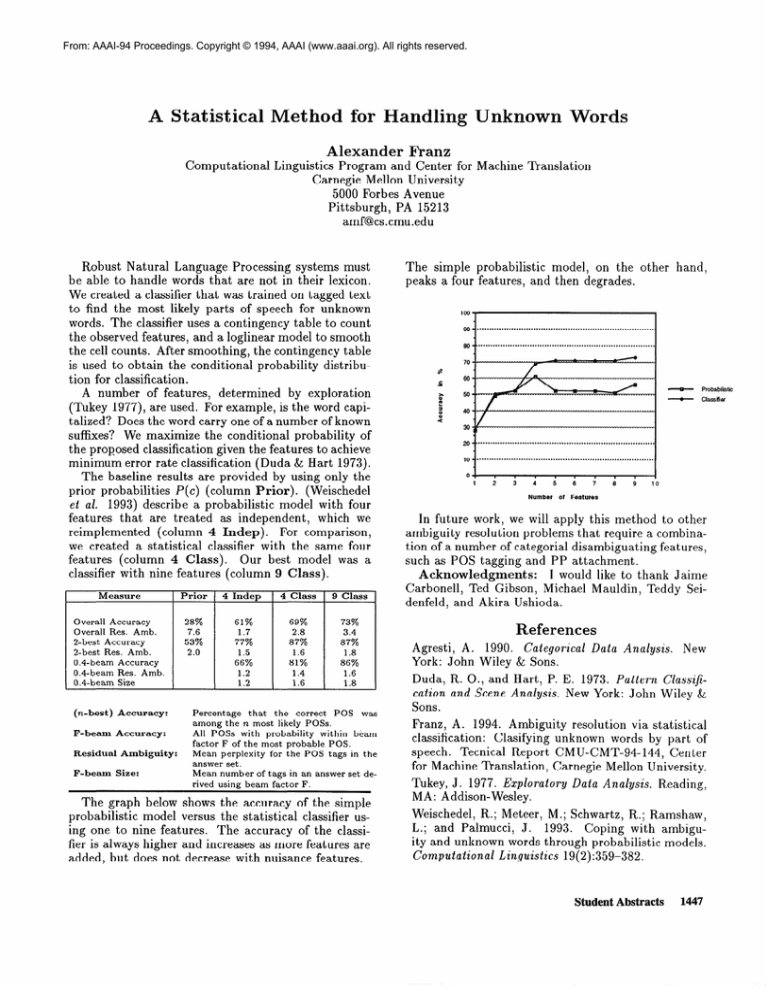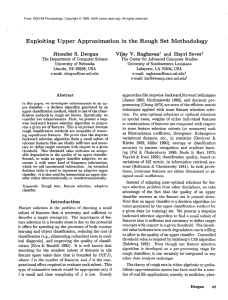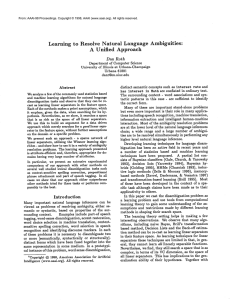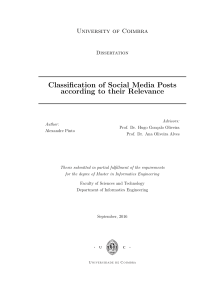
From: AAAI-94 Proceedings. Copyright © 1994, AAAI (www.aaai.org). All rights reserved.
A Statistical Method
for Handling Unknown Words
Alexander
Computationa
Robust Natural Language Processing
systems must
be able to handle words that are not in their lexicon.
We created a classifier that was trained on tagged text
to find the most likely parts of speech for unknown
words. The classifier uses a contingency table to count
the observed features, and a loglinear model to smooth
the cell counts. After smoothing, the contingency table
is used to obtain the conditional probability
distribution for classification.
A number of features,
determined
by exploration
(Tukey 1977), are used. For example, is the word capitalized? Does the word carry one of a number of known
suffixes?
We maximize the conditional probability
of
the proposed classification given the features to achieve
minimum error rate classification
(Duda & Hart 1973).
The baseline results are provided by using only the
prior probabilities
P(c) (column Prior).
(Weischedel
et al. 1993) describe a probabilistic
model with four
features
that are treated as independent,
which we
reimplemented
(column 4 Indep).
For comparison,
we created a statistical
classifier with the same four
Our best model was a
features (column 4 Class).
classifier with nine features (column 9 Class).
Measure
Overall Accuracy
Overall Res. Amb.
2-best Accuracy
2-best Res. Amb.
0.4-beam Accuracy
0.4-beam Res. Amb.
0.4-beam Size
(n-best)
Accuracy:
F-beam
Accuracy:
Residual
F-beam
Ambiguity:
Size:
1 Prior
I
28%
7.6
53%
2.0
1 4 Indep
i
61%
1.7
77%
1.5
66%
1.2
1.2
Franz
,l Linguistics Program and Center for Machine
Carnegie Mellon University
5000 Forbes Avenue
Pittsburgh,
PA 15213
amf@cs.cmu.edu
1 4 Class
I
1 9 Class
I
69%
2.8
73%
3.4
87%
87%
1.6
81%
1.4
1.6
1.8
86%
1.6
1.8
Percentage
that the correct POS was
among the 12most likely POSs.
All POSs with probability within beam
factor F of the most probable POS.
Mean perplexity for the POS tags in the
answer set.
Mean number of tags in an answer set derived using beam factor F.
The graph below shows the accuracy of the simple
probabilistic
model versus the statistical
classifier using one to nine features.
The accuracy of the classifier is always higher and increases as more features are
added, but does not decrease with nuisance features.
Translation
The simple probabilistic
model, on the other
peaks a four features, and then degrades.
,o
hand,
. . . . . . . . . . . . . . . . . . . . . . . . . . . . . . . . . . . . . . . . . . . ..-..........................
i
04
1
,
,
,
,
,
,
,
,
2
3
4
5
6
7
6
9
Number
of
I
1
10
Features
In future work, we will apply this method to other
ambiguity resolution problems that require a combination of a number of categorial disambiguating
features,
such as POS tagging and PP attachment.
Acknowledgments:
I would like to thank Jaime
Carbonell,
Ted Gibson, Michael Mauldin, Teddy Seidenfeld, and Akira Ushioda.
References
Agresti, A. 1990.
Categorical
York: John Wiley & Sons.
Data Analysis.
New
Duda, R. O., and Hart, P. E. 1973. Pattern Classifycation and Scene Analysis. New York: John Wiley &
Sons.
Franz, A. 1994. Ambiguity resolution via statistical
classification:
Clasifying unknown words by part of
speech. Tecnical Report CMU-CMT-94-144,
Center
for Machine Translation,
Carnegie Mellon University.
Tukey, J. 1977. Exploratory
MA: Addison-Wesley.
Data Analysis.
Reading,
Weischedel, R.; Meteer, M.; Schwartz, R.; Ramshaw,
L.; and Palmucci,
J.
1993.
Coping with ambiguity and unknown words through probabilistic
models.
Computational
Linguistics 19(2):359-382.
Student Abstracts
1447








